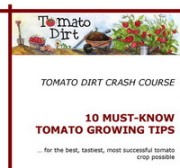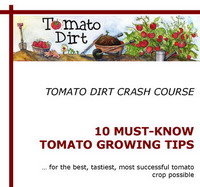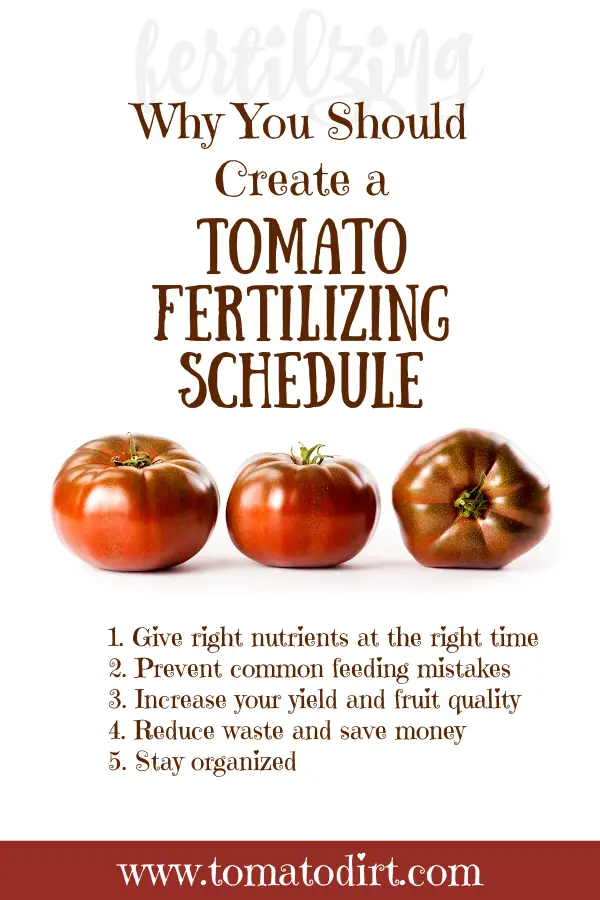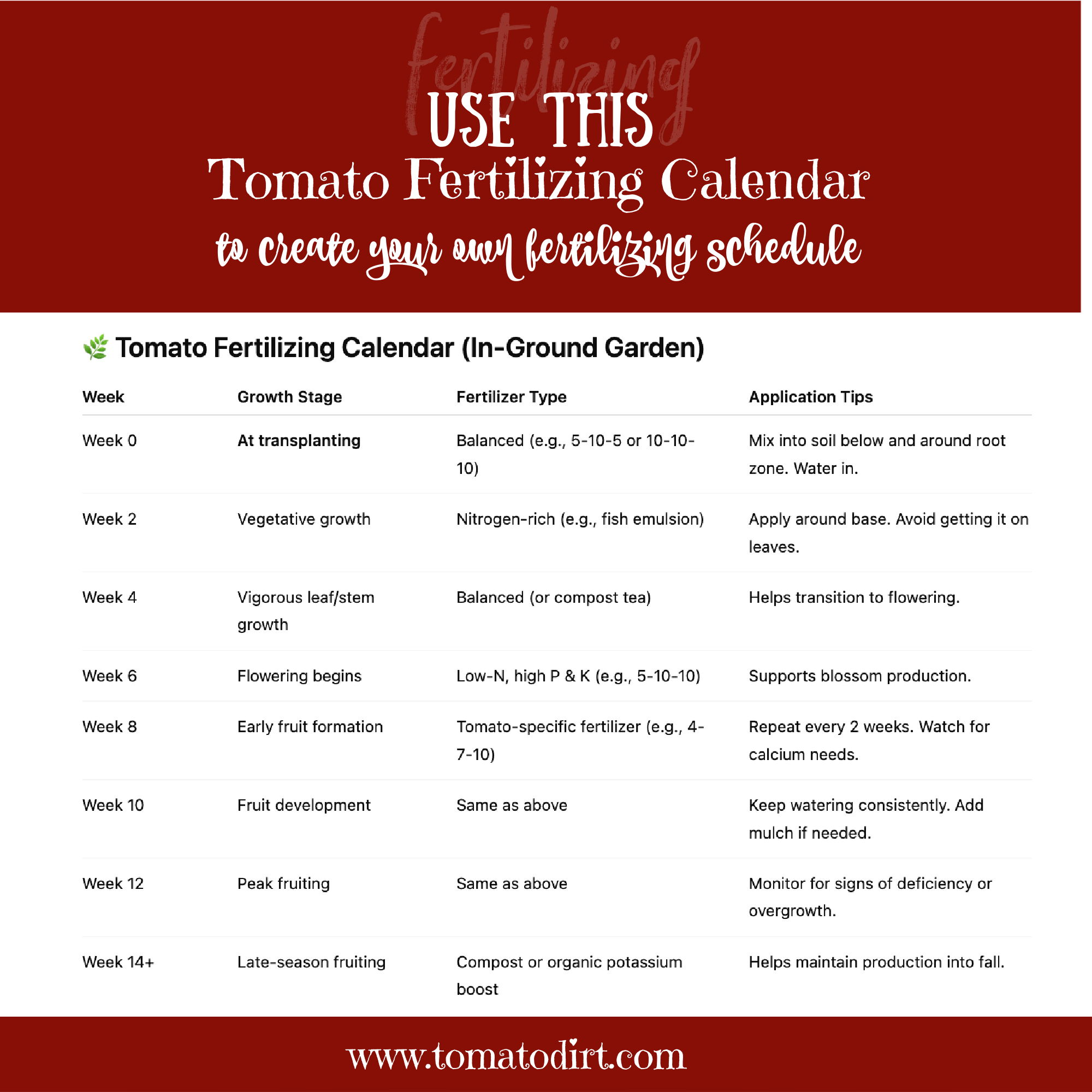FREE: 10 Must-Know Tomato Growing Tips Get The Guide
Read our affiliate disclosure here.
What’s the Best Tomato
Fertilizing Schedule?
Since 2010, Tomato Dirt has garnered 4.8+ million views, making it the web’s leading online source for growing tomatoes in the home garden. Award-winning writer and Tomato Dirt owner Kathy Widenhouse has helped thousands of home gardeners grow healthier tomatoes. Be one of them when you get Tomato Dirt’s Growing Guide here.
Posted 6.10.25
Ever wonder if your tomato plants could produce more fruit … larger fruit … fruit with more intense flavors?
They can. By using a tomato fertilizing schedule you ensure your plants get the right nutrients at the right time. That leads to healthier plants and better harvests.
Even if you already use fertilizer, a schedule brings structure, consistency, and better results – whether you're growing a few plants in containers or running a large backyard garden.
Good reasons to create a tomato
fertilizing schedule
1. A fertilizing schedule provides the right nutrients at different growth stages
Tomatoes need:
- Nitrogen early for leafy growth
- Phosphorus during flowering and fruiting
- Potassium to support fruit development and overall plant health
A tomato fertilizing schedule helps you apply the correct nutrients during each stage so you can avoid under- or over-fertilizing at different points in the season.
2. A fertilizing schedule prevents common mistakes
Without a schedule, it’s easy to use too much nitrogen and get lots of leaves but no fruit …fertilize too late, causing green tomatoes to stop ripening … fertilize inconsistently, which stresses the plant. A regular plan reduces guesswork.
3. A fertilizing schedule increases yield and quality
Tomatoes that receive consistent, balanced nutrition are more productive. Better nutrition means more flowers and fruits. Plus, the fruit you pick has more intense flavor. The right nutrients at the right time means less blossom end rot and fewer tomato cracks.
4. A fertilizing schedule reduces waste and saves money
By fertilizing tomato plants at the correct time and rate, you’re not wasting fertilizer by applying more than you need. Instead, nutrients are absorbed into the plant. There’s less leaching and runoff into your surrounding environment.
5. A fertilizing schedule helps you stay organized
With a fertilizing schedule, you can track when you last fed your plants and observe their response. Then you can adjust dosage based on signs of deficiency or excess. And if you’re using an organic approach, you can time compost tea, fish emulsion, or slow-release organic feeds according to your weather conditions and soil.
How to create the best tomato fertilizing schedule for your garden
Here’s a basic guide you can tailor to your garden.
Planting stage
- Frequency: Once.
- Type of fertilizer: Before planting, test you soil to see if there are clear deficiencies and if so, amend accordingly. Then add organic matter like compost or aged manure to your garden plot to ensure overall health and adequate nutrition. Finally, add a balanced fertilizer to the soil when you plant tomatoes, such as 10-10-10 or 5-10-5.
- Purpose: Encourage your plant to build a strong root system.
Early growth stage: 3-4 weeks
after planting
During this stage, tomato plants focus on leaf and stem growth. Nitrogen is particularly important during this phase, as it promotes lush foliage.
- Frequency: Every 2 weeks until plants reach about 12 inches tall.
- Type of fertilizer: Higher nitrogen (10-5-5) if needed. If plants are already leafy and green, don't add extra nitrogen.
- Purpose: Help your plant build strong stems and leaves.
Flowering stage: once first blossoms
emerge
When your tomato plants start putting out flowers, it is time to add more phosphorus to promote blossoming and cut back on nitrogen … unless you simply want nice tomato leaves.
- Frequency: Every 1–2 weeks.
- Type of fertilizer: Low nitrogen, higher phosphorus and potassium, such as 5-10-10, to promote flowering and fruiting.
- Purpose: Promotes flowering and healthy fruit set.
Fruiting and ripening: from first
ripening to end of season
At this point, tomato plants
require a balanced supply of nutrients to support healthy fruit growth and
prevent nutrient deficiencies. Higher potassium content can result in more
sugar in the fruit, which affects the flavor. Too much nitrogen will result in
tomato puffiness, and the flavor won't be as good.
- Frequency: Every 1–2 weeks – less often if you’re using a slow-release fertilizer.
- Type of fertilizer: Continue using a balanced fertilizer or switch to a slightly higher potassium content formulation, such as a 10-10-20 or 5-10-20 formulation.
- Purpose: Keep your plants healthy and productive until the end of the season. Watch for blossom end rot or yellowing leaves, which are signs of calcium or nutrient imbalance.
When to fertilize tomatoes: FAQs
Q. Should I fertilize tomato seedlings?
Once the seedling has popped through the soil and has at least two sets of true leaves, its initial food source (the body of the seed) is depleted. At this point, you can start applying a diluted fertilizer when watering.
Be careful with applying fertilizer at this stage. These little guys can easily be burned by too much of a good thing. Using a liquid fertilizer that is diluted to half strength will be sufficient. Water from the bottom to avoid getting fertilizer on the stem.
Q. What time of day is best for fertilizing tomatoes?
The best time to fertilize tomatoes is in the early morning or late afternoon. This timing allows the plants to absorb nutrients more effectively when temperatures are cooler and reduces the risk of fertilizer burn during hot midday sun. Early morning is often preferred because it gives the plants ample time to absorb nutrients before the day heats up.
Q. How often to fertilize tomatoes
in-ground?
It depends on your plant’s growth stage (see above). But a good rule of thumb is every two weeks.
Q. How often should I fertilize
tomatoes in pots?
Containers have less soil volume than an in-ground garden and frequent watering means nutrients leach out easily. Plan to fertilize your tomatoes in pots more frequently than tomatoes in your garden plot.
First, choose a slow-release fertilizer (like Osmocote) to your containers when planting. Nutrients will disperse over time. You can also consider adding a small amount of water-soluble fertilizer like Miracle Gro Tomatoes into your watering can. Monitor you plants to see if you’re fertilizing too much (and the plants simply produce leaves) or not enough (low production and yellow foliage.) Some gardeners fertilize their tomatoes in pots as often as once a week.
Q. When should I stop fertilizing my
tomato plants?
When the season is coming to an end, slow and finally stop adding nutrients to the soil. Doing so will help to ripen the remaining green tomatoes on your vines. And it will help you save those precious nutrients for next year’s crop.
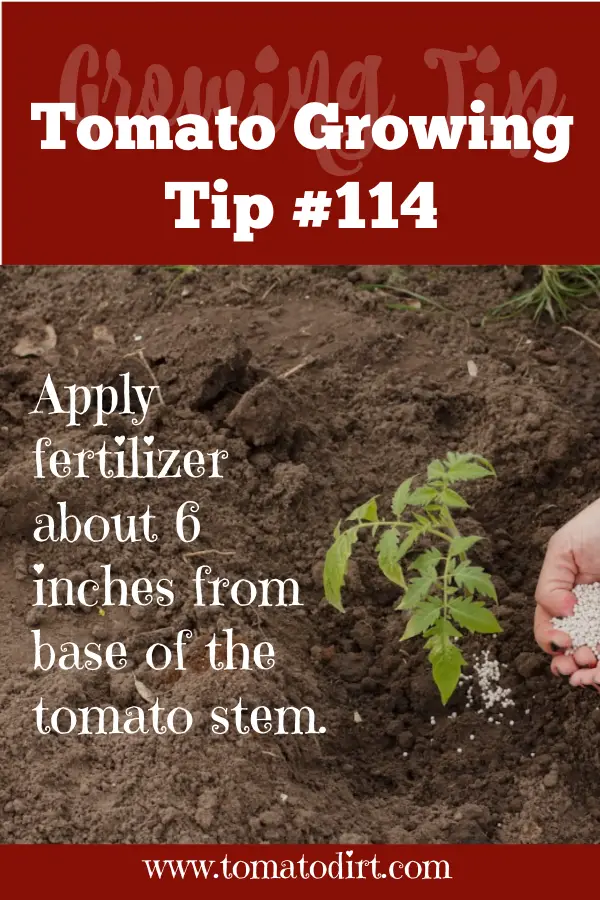
More tips for your tomato fertilizing schedule
- To avoid root burn, water your tomato plants before applying fertilizer. Then water thoroughly after applying fertilizer to help nutrients reach the roots.
- Apply fertilizer around the base of the plant, about 6 inches away from the stem. You’ll help prevent leaf burn.
- Adjust schedules based on local weather conditions and the specific needs of your tomato plants.
- Mulch your tomato plants to help retain nutrients and moisture.
- Monitor plant growth and leaf color; adjust fertilizer type and frequency as needed.
What’s the best tomato fertilizing schedule?
Any gardener knows that gardening methods are not a “one-size-fits-all.” That goes for fertilizing tomatoes, too. So much depends on your soil, your weather, when you plant tomatoes, what tomato varieties you grow, and when they bloom.
For instance, let’s say you plant early season tomato varieties like Early Girl or Fourth of July. Those plants blossom sooner than long season varieties by Brandywine … and that means you’ll begin applying extra phosphorus and potassium earlier in the season.
That’s why you need to create a personalized tomato fertilizing schedule. Set it up with your planting dates. Then take note of how your plants respond as stems and leaves multiply … what dates plants begin flowering … when the first fruits appear. Record the kind of fertilizer you use and how much.
Keep your tomato fertilizing schedule in your garden journal and refer to it next year. With a schedule, you’ll have a head start on a healthy crop both this year and next!
More on Fertilizing Tomatoes
What Nutrients Do Tomatoes Need?
How to use tomato fertilizer to get the best tomato production...
Kinds of tomato fertilizer ...
Organic tomato fertilizer: advantages and disadvantages...
Epsom salts: a natural tomato fertilizer ...
Does tomato fertilizer potency stay strong over time?
Tomato fertilizer question: will this fertilizer work for tomatoes?
See more on our Fertilizing Tomatoes Pinterest board...
Return from Best Tomato Fertilizing Schedule to Tomato Dirt home
As an Amazon Associate and Rakuten Advertising affiliate I earn from qualifying purchases.
SHARE THIS PAGE:
FREE! 10 Must-Know Tomato Growing Tips: 20-page guide
Get yours here:
